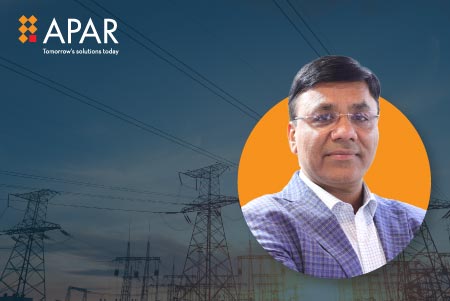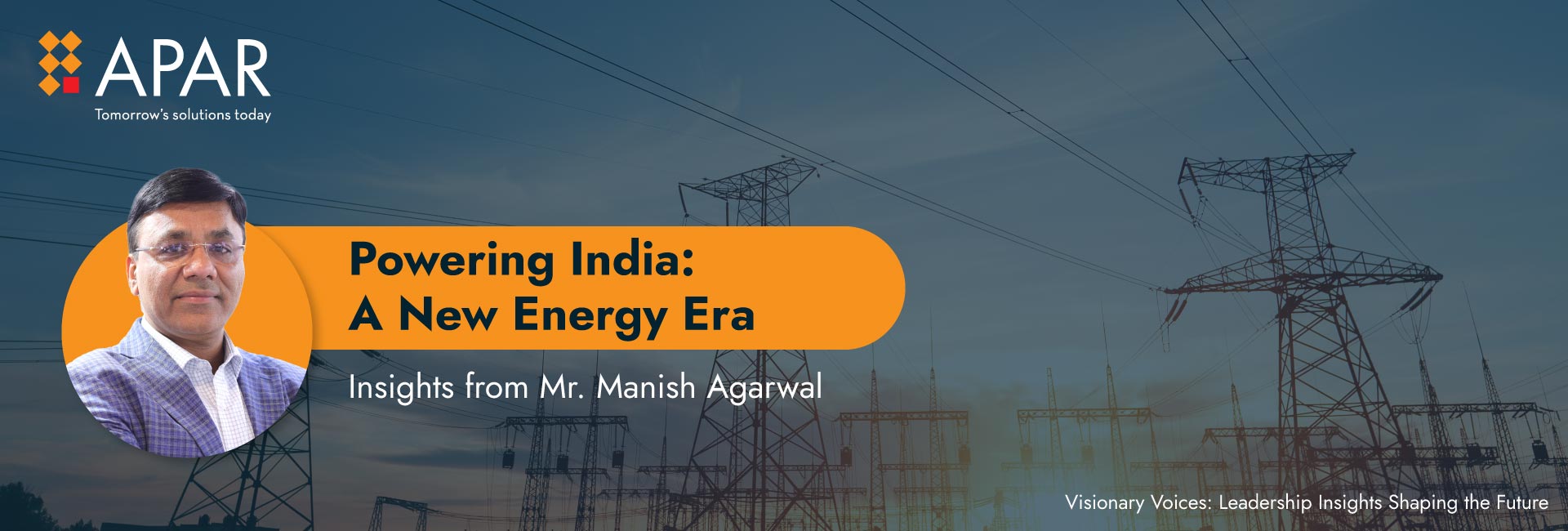Powering India: A New Energy Era


Mr. Manish Agarwal, CEO of the Conductor and Telecom Businesses and Managing Director of APAR T&D Projects Private Limited, outlines the critical trends shaping electricity demand in India and the strategic initiatives undertaken by APAR. His perspectives offer a comprehensive understanding of the current energy landscape, highlighting the interplay between economic growth, technological advancements, and environmental commitments.
Energy Evolution: The Trends Transforming India’s Electricity Landscape
India’s Economic Resilience and Growth remain robust despite global uncertainties. The economy is projected to grow by 8.2% in FY 24, reaching approximately $3.5 trillion, which lays the groundwork for achieving the ambitious $5 trillion target. This growth is closely linked to increasing electricity demand, as India’s per capita energy consumption currently stands at roughly 1,300 kilowatt-hours—significantly below the global average of 3,000 kilowatt-hours. As per various estimates, including that of Central Electricity Authority (CEA), this figure could rise to between 1,800 and 2,000 kilowatt-hours per year by 2030, mainly due to rising industrial activity and urbanization, fuelling the next phase which is Decarbonization Efforts.
The imperative for decarbonization is a pivotal factor driving electricity demand. India’s hydrogen mission exemplifies this commitment, aiming to leverage renewable energy (RE) for green hydrogen production. This initiative supports industrial applications and enhances energy storage and grid management capabilities. As the mission progresses, it is anticipated that electricity demand from renewable sources will surge, closely followed by Urban Migration Trends.
Urbanization is another significant contributor to electricity demand growth. The World Bank estimates that by 2031, 40% of India’s population will reside in urban areas—up from 31% in 2011. This demographic shift necessitates substantial upgrades to energy infrastructure to meet the needs of expanding urban centres, while simultaneously, Climate action is poised to catalyse investments in renewable energy and power grids. According to the International Energy Agency (IEA), achieving net-zero emissions will require an estimated $4.5 trillion investment in clean energy by 2030, which is a 2.5x increase from current levels. India’s commitments made during COP26 highlight its dedication to reducing emissions intensity by 45% from 2005 levels by 2030, integrating 500 gigawatts of non-fossil energy into the grid & meeting 50% of its energy requirements from renewable energy by 2030 and achieving net-zero status by 2070. To match the renewable energy capacity addition speeds, the transmission projects need to come online by 2028-29.
Powering Forward: APAR’s Strategic Blueprint for India’s Energy Evolution
At APAR, we’re at the forefront of this challenge, upgrading and revolutionising energy transmission across the country. As the largest one-stop solution provider for design, manufacturing, upgrading of transmission lines and testing of conductors in the world, and the world’s largest global aluminium and alloy conductor manufacturer we’re striving to build a greener, more energy-efficient tomorrow, one project at a time.
APAR offers end-to-end EPC solutions, specializing in turnkey projects for the power sector. APAR’s expertise includes designing, manufacturing, and testing, as well as live line replacement of OPGW.Furthermore the company has made substantial capital investments aimed at expanding production capabilities and enhancing operational efficiency, leading to Innovative Product Offerings. The company’s commitment to developing high-temperature low-sag conductors, continuous transposed conductors, covered conductors, and coated conductors while maintaining a Sustainability Commitment. APAR’s mission revolves around creating energy-efficient and environmentally sustainable solutions. By integrating advanced technologies into its manufacturing processes, APAR aims to meet the increasing demand for reliable energy infrastructure while adhering to stringent environmental standards.
Building the Future: Major Infrastructure Opportunities in India’s Energy Sector
India’s ambitious Offshore Wind Projects present significant multi-year opportunities across various sectors. The Ministry of New and Renewable Energy (MNRE) has identified high wind energy zones off the coasts of Gujarat and Tamil Nadu, targeting a total capacity of 37 gigawatts. Recent government approval on the scheme for offshore wind energy projects further underscores this commitment, supplemented by High Voltage Direct Current (HVDC) Projects. The development of large HVDC projects represents another critical area of focus for APAR Industries Limited. The mega transmission highways in the form of HVDC are essential for integrating renewable energy sources into the grid effectively, along with the requirements for the Railways.
Railways are planning to increase the capacity on many of the existing corridors for increasing the speed of the trains. With the largest market share, a very good track record on the supply (supplied 31,000 KMs out of 45,000 KMs of electrification), and development of special conductors (Cu-Ag Contact wire, Cu-Mg Catenary wires) for high speed and bullet trains, APAR is well-poised to address the needs of Railways and help it to become the largest rail network with zero carbon emission by 2030, as well as opportunities with OPPC. APAR has leveraged its core strengths to design and manufacture Optical Phase Conductor (OPPC) cables, suitable for 33 kV and 66 kV transmission lines. We are preparing to undertake a pilot turnkey project and then commercialize the end-to-end offering, and ongoing Capex. APAR has undertaken strategic capex to expand capabilities, improve productivity, reduce costs, and increase production capacity for value-added products. The capacity is expected to nearly double for copper CTC/PICC and AL-59/AAAC conductors and increase by 166% for copper busbar in FY25 (from FY23 levels).
Globally, we are also targeting partnerships with various utilities and EPCs to expand our market presence. The ‘One World, One Sun, One Grid’ initiative signifies a monumental shift toward a global energy-sharing framework. Its implementation will drive substantial demand for various equipment and solutions ranging from HVDC transmission lines to smart grid technologies and renewable energy stations, all underpinned by Technology & Solutions. APAR is at the forefront of innovation with over six decades of experience in technology partnerships for advanced products. Our new product development initiatives include trials for coated conductors that promise reduced line losses, increased conductor capacity & improved durability in challenging environments; reconductoring solutions with HTLS using Emergency Restoration Systems (ERS).
Additionally, we are working on end-to-end capability turnkey solutions for Medium Voltage Covered Conductors (MVCC) and an enhanced version of Aluminum Carbon Composite Core Conductor (ACCC), with optical fiber embedded in the core, while managing Ampacity and Low Losses. Due to Right of way (ROW) challenges, there is a need to debottleneck the current transmission lines through advanced products focusing on higher ampacity and low loss technologies. APAR’s HTLS conductors, coated conductors and reconductoring solutions help achieve higher capacities and lower losses.
Mr. Agarwal’s insights provide a detailed overview of the factors influencing electricity demand in India while highlighting APAR’s proactive approach in addressing these challenges. As India embarks on a transformative journey toward sustainable energy solutions, APAR remains committed to India’s overarching goals for economic growth and environmental sustainability.